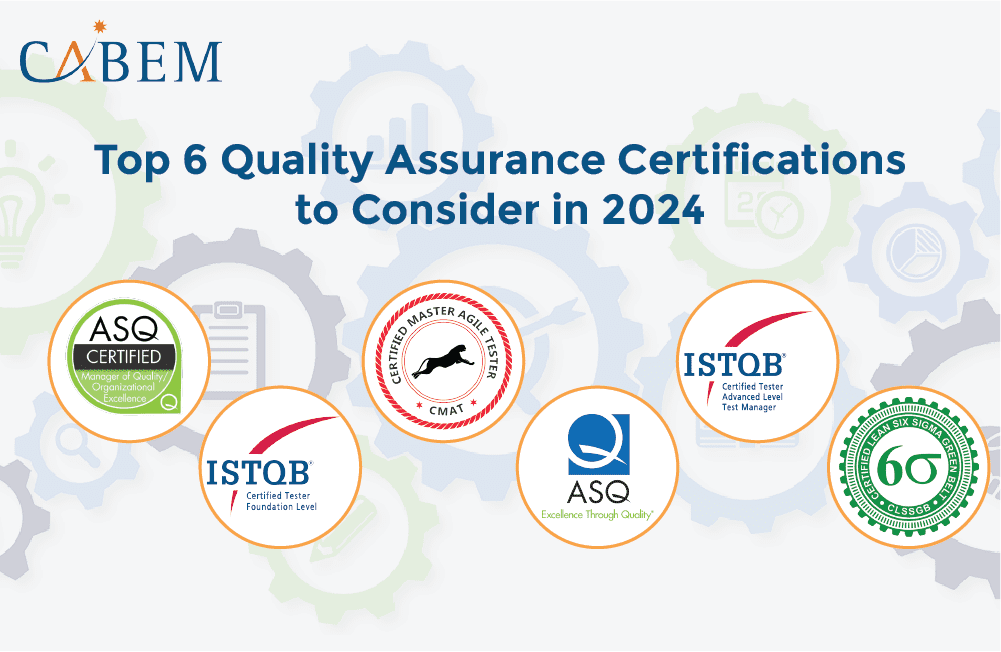Quality assurance (QA) certifications are essential for software manufacturing. They help businesses meet industry standards and deliver the best possible products.
Businesses with valid ISO certifications can proudly vouch that they value quality above all. These certifications also benefit buyers by adding an extra layer of assurance. Clients will happily invest in products or services that meet quality standards.
In this blog, we’ll dive deep to understand quality assurance and its standards. We’ll then introduce you to some of the most in-demand software QA certifications.
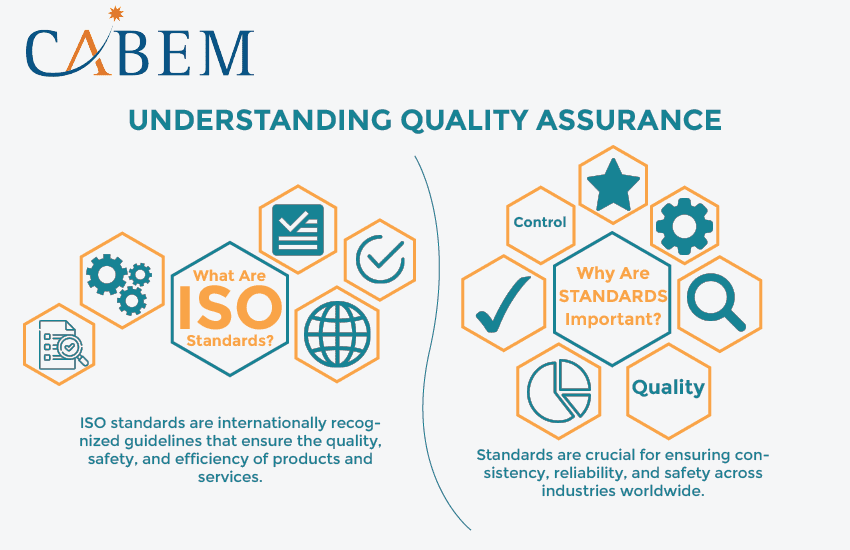
Understanding Quality Assurance
Quality assurance is the process of ensuring software applications meet the specified quality criteria. It acts as a shield of valor for businesses aiming to guarantee the caliber of a software product.
To stay ahead of the curve, professional software testers incorporate manual and automation techniques. Mixing the two methods allows them to get broader tеst covеragе, fastеr fееdback, and rеducеd costs.
Fortunе Businеss Insights expects the global automation tеsting markеt to reach $51.26 billion by 2030 with a CAGR of 18.8%. With cloud-based automation testing solutions in the mix, these stats are quickly gaining pace. Businesses leveraging the Cloud have more scalability, flexibility, and collaborative opportunities.
What Are ISO Standards?
The International Organization for Standardization (ISO) develops and publishes international standards. As an independent, non-governmental organization, ISO sets the bar for quality worldwide.
ISO applies to all sorts of industries and has over 22,600 standards and related documents. This number increases by the day as new trends and technologies emerge.
Now, we understand that grasping all ISO standards is difficult. But, it is important to know which ones are the most suitable for your business. To make things easier, let’s have a quick overview of the most common standards. These quality assurance standards are generic, and most organizations – regardless of their sector – can apply them.
- ISO 9001 – Quality Management System(QMS)
- ISO 14001 – Environment Management System
- ISO 27000 – Information Security Management System
- ISO 50001 – Energy Management System
- ISO 31000 – Risk Management
- ISO 13485 – QMS for Medical Devices
- ISO 45001 – Occupational Health and Safety
- ISO 28000 – Supply ChainSecurity Management System
Why Are Standards Important?
Standards are crucial because they ensure compatibility and interoperability across various industries. They facilitate smooth operations, allowing products to connect seamlessly and services to meet regulatory requirements, which is essential for global commerce and travel.
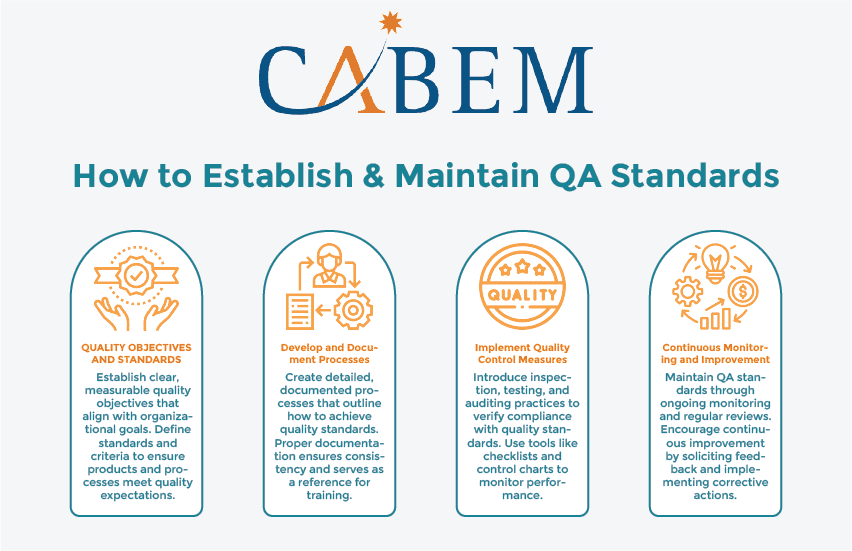
How to Establish & Maintain QA Standards
Developing and maintaining quality standards in a company starts with a comprehensive quality plan that defines scope, roles, criteria, and tools for QA activities such as audits and inspections. This plan integrates risk management and feedback mechanisms, ensuring continuous improvement through regular updates and stakeholder communication. Analyzing QA results highlights areas for corrective actions and promotes a quality-centric culture with ongoing training and stakeholder engagement.
To efficiently manage these QA processes, consider using CABEM’s Competency Management System. This tool automates tasks, tracks objectives, and monitors performance, allowing your team to focus on delivering exceptional quality. CABEM’s system supports continuous improvement and helps keep your quality measures aligned with industry standards and customer expectations, streamlining the maintenance of high QA standards.
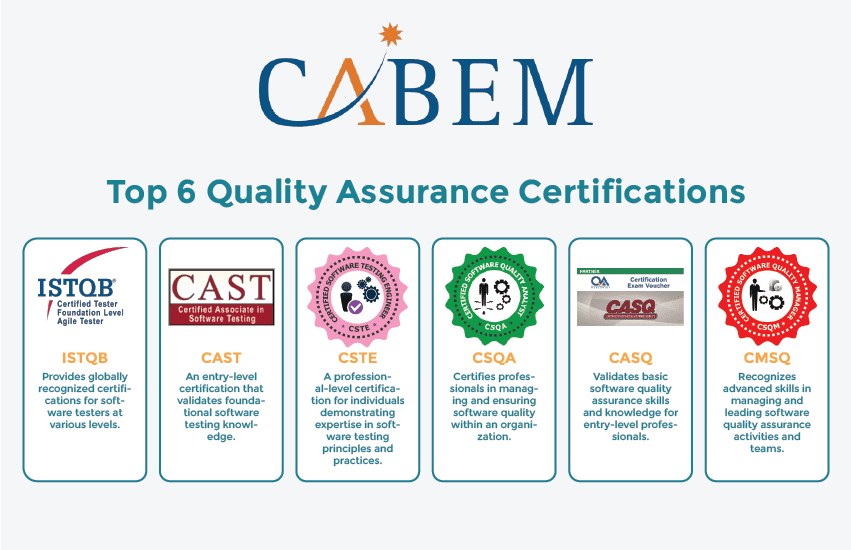
Top 6 Quality Assurance Certifications
Ready to boost your employees’ testing skills and help them gain practical experience? The following certifications range from beginner to advanced levels. You can use this as a roadmap to guide your staff members in becoming a certified QA expert:
International Software Testing Qualifications Board (ISTQB)
The ISTQB certification is a highly sought-after foundational credential for entry-level QA professionals. It validates their competency in core testing concepts, methodologies, and best practices.
While not a prerequisite for a QA career, an ISTQB certification demonstrates a strong foundation – making candidates a more attractive hire. To register for the ISTQB exam, your employees will need to meet one of the following requirements:
- Bachelor’s degree + 4 years in QA.
- Associate’s degree + 6 years in QA.
- Minimum 8 years of relevant QA experience.
Certified Associate in Software Testing (CAST)
The CAST certification is a great starting point for aspiring QA professionals. Unlike many certifications, CAST removes the experience barrier. Beginners can break into the technical side of software testing with ease.
This foundational-level program equips your employees with the insights to both QA (Quality Assurance) and QC (Quality Control). They’ll master basic testing techniques and gain a solid springboard for growth. The following prerequisites are what they’ll need to qualify for the CAST exam:
- A 3 or 4-year degree from an accredited institution.
- A 2-year degree from an accredited institution with 1 year of relevant experience.
- A minimum of 3 years of experience in the field (without a formal degree).
Certified Software Tester (CSTE)
The CSTE certification is a highly sought-after credential for mid-career QA professionals. This program validates an individual’s expertise in software quality. CSTE goes beyond entry-level certifications as it dives deeper into testing methodologies. When your employees achieve this credential, you can proudly show stakeholders that you’re serious about software quality.
To qualify, candidates will need 18 months of practical experience along with these prerequisites:
- A 4-year degree + 2 years of experience.
- A 3-year degree + 3 years of experience.
- A 2-year degree + 4 years of experience.
- OR 6 years of straight experience in information services.
Certified Software Quality Analyst (CSQA)
CSQA is the gold standard for an experienced QA analyst. The CSQA certification goes beyond CSTE. Think of it as the advanced version for experienced testers. It demonstrates the individual’s mastery of the QA domain and opens doors to leadership positions.
The eligibility requirements for CSQA mirror those of the CSTE certification:
- 4-year degree + 2 years of experience.
- 3-year degree + 3 years of experience.
- 2-year degree + 4 years of experience.
- OR 6 years of hands-on experience.
Just like CSTE, candidates will need 18 months of recent experience before applying for the CSQA certification.
Certified Associate in Software Quality (CASQ)
The CASQ certification validates the candidate’s grasp of core QA principles and practices. This program is for those new to the QA field or seeking a broader understanding of core principles. CASQ fills a gap that experience alone may not address. This foundational credential demonstrates one’s commitment to professional development within the field.
To qualify for the CASQ exam, candidates will need to meet one of the following requirements:
- A bachelor’s degree (3 or 4 years).
- An associate’s degree (2 years) with 1 year of relevant experience.
- 3 years of hands-on experience in information services.
Certified Manager of Software Quality (CMSQ)
This certification is for experienced QA professionals seeking to transition into leadership roles. CMSQ goes beyond technical expertise. It equips candidates with the necessary leadership skills to manage and inspire QA teams. This advanced credential validates their competency, knowledge, and leadership abilities.
The eligibility requirements for CMSQ are stringent as this is an expert-level certification. Eligible candidates will need a combination of education, experience, and a foundational QA certification. The prerequisites include:
- Bachelor’s degree + 4 years in QA.
- Associate’s degree + 6 years in QA.
- Minimum 8 years of relevant QA experience.
Additionally, they’ll need one of these:
- Bachelor’s degree + 4 years of QA experience.
- Associate’s degree + 6 years of QA experience.
- Minimum of 8 years of relevant QA experience.
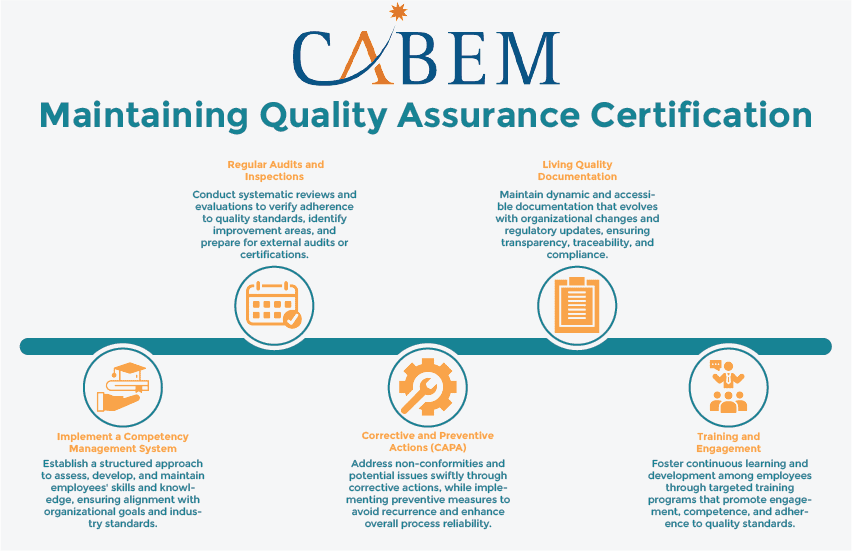
Maintaining Quality Assurance Certification
When an employee obtains a QA certification, it shows their dedication to quality. But it’s not a one-time achievement. Their commitment to continuous improvement is essential to ensure the certification’s continued value.
Here are key strategies your employees can implement to uphold high-quality standards:
- Implement a Competency Management System: Consider a dedicated Competency Management System to track renewals, identify skill gaps, and foster knowledge sharing for a future-proof QA team.
- Regular Audits and Assessments: Evaluate compliance with QA standards through regular audits. These assessments detect improvement scope, mitigate risks, and ensure adherence to best practices.
- Corrective and Preventive Actions (CAPA): Effectively address non-conformances identified during audits. Implement CAPA plans to rectify root causes and prevent similar issues. This enhances overall quality performance.
- Living Quality Documentation: Maintain accurate, up-to-date QA documentation that reflects current practices. Regularly revise these documents to ensure accessibility and alignment with best practices.
- Training and Engagement: Invest in continuous training. One should be aware of the latest quality standards, systems, and tools. Measure the impact of training to ensure effectiveness. Foster a culture of quality awareness and excellence by recognizing employee contributions.
By following these practices, your employees demonstrate a commitment to continuous improvement. You can encourage them to maximize the value of their QA certification and enforce quality across your company.
Conclusion
The software development landscape is evolving rapidly. This revolution has brought in an unprecedented demand for quality assurance. QA certifications are essential tools for businesses looking to:
- Find top talents
- Demonstrate their dedication to high-quality standards
- Boost customer satisfaction
- Gain a competitive edge
- Minimize risks
In this guide, we have equipped you with a roadmap to navigate the diverse world of QA certifications. Remember, the ideal certification aligns seamlessly with business goals. Don’t underestimate the power of market relevance. Research in-demand certifications and programs within your target market to maximize your return on investment and build a future-proof QA team.
Ready to streamline your certification management? With CABEM’s Competency Management System, you can effortlessly track certification renewals, prepare for audits, and ensure all team members meet the necessary standards. Request a free demo today and see how CABEM can help you maintain exceptional quality standards with ease.
Frequently Asked Questions (FAQs)
Q1: How does implementing a risk management system in QA contribute to cost reduction?
Proactive risk management offers a significant return on investment. Risk management and QA to identify and mitigate risks early in the development cycle. Businesses can prevent costly product recalls, warranty claims, and rework activities. Risk reduction improves product quality, optimizes resource allocation, and minimizes waste. This results in sustainable cost savings for the organization.
Q2: What are the best practices for integrating risk management into QA processes?
Three pillars support the seamless integration of risk management in QA. These include:
- Risk-Aware Culture: Embed risk awareness within the QA team.
- Aligned Goals: Sync risk management with broader organizational goals.
- Clear Communication: Establish open channels for collaboration.
Businesses can further enhance efficiency using the risk assessment tool CABEM offers.
Q3: How does technology empower QA teams in risk management?
Technology is a game-changer for QA teams. Tools like CABEM’s Risk Manager provide:
- Advanced risk assessments
- Predictive analytics
- Real-time monitoring
- Deeper understanding of potential vendor risks
Such tools aim to boost efficiency. They also ease clear communication between vendors, auditors, and internal stakeholders.

